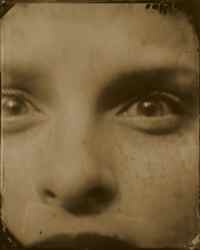Victorian Post-Mortem Photography is something I have found fascinating for some time, and its history is very revealing.
With the invention of photography in 1839, many people who couldnt afford to pay for a painted portrait could afford a photography session. Rather than a reminder of mortality, they were more a keepsake to remember the deceased, especially with infants and children. Infant/child mortality rates were very high, and this post-mortem photograph might be the only image of a child that the family ever had.




Post-mortem photography has ceased in North America and Western Europe as it is considered vulgar, sensationalist and taboo, although it is still fairly popular in Eastern Europe.
Contemporary photographers who have death or the dead as their main themes include:
Andres Serrano-American photographer and artist who photographed morgue photographs of the dead in a beautiful, artistic way, including the bodies of the young.



Sally Mann-American Photographer best known for her black and white photography of children, and landscapes of decay and death.
Her 5th book, 'What Remains' (2003) is in 5 parts;
- The remains of her pet greyhound
- The dead and decomposing bodies at a federal forensic anthropology facility (or the 'body farm', a place where bodies are left exposed to the elements so scientists can study the effects off decomposition)
- The site on her property where an armed escaped convict was killed
- A study of the grounds of Antietam, the site of the bloodiest single day battle in the american civil war
- a study of close ups of the faces of her children.




Maeve Berry-An Irish photographer who created her series 'Incandescence' in direct response to the Victorian death photography. In her words, "a series of images capturing the last moments of the human body in the material world." she has taken pictures of the cremator as it reduces the human body to ash, resulting in some beautiful and poignant pictures.



Pep Bonet-A Spanish photographer. In Petit-Goave, one of the suburbs of Port-au-Prince in Haiti, a hospice is hosting old and mentally challenged people. Following the earthquake, more people took refuge there. There are now 71 inmates while they were only 40 before the quake. The number is growing. The hospice was flooded during the earthquake and received no assistance.
In the series "Hospice" Pep Bonet portrayed the daily life of these patients in June 2010.
I found these images very inspirational, of course the Hospice I am photographing is nothing like this, but the plight of the sick never really changes. The conditions in this place really upset me, and made me really think about what was still happening in Haiti.
Haitian Hospice
Eric Lafforgue-A french photographer who travels the world photographing different kinds of people. His photography I find incredibly beautiful, his portraits are so inspiring and full of life, I hope one day to do something half as good as his work.





Finally, I got inspiration from this set of images that, although they dont have a sole photographer, are still haunting, detailed and very intimate. A Romanian prison gave its female inmates 6 canon powershots, and in the first 2 months alone they took over 14,000 photographs. I have found these fascinating and have looked through them numerous times, it is an amazing look at the lives and relationships of these women, and they are surprisingly artistic at times and occasionally very poignant.
original source





this next one reminds me of 'migrant mother'

No comments:
Post a Comment